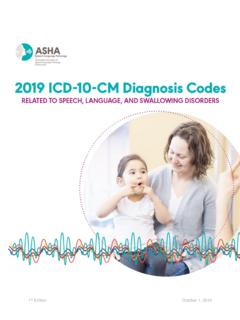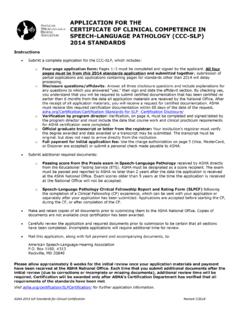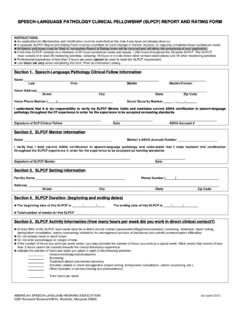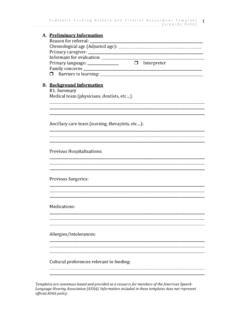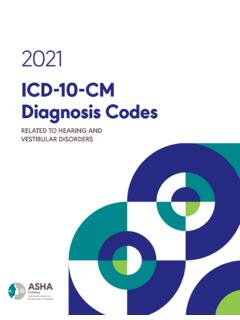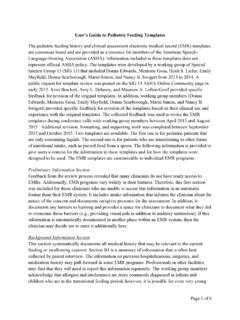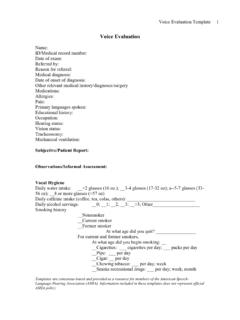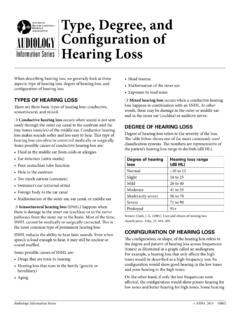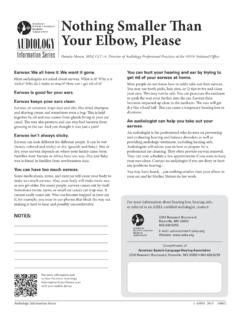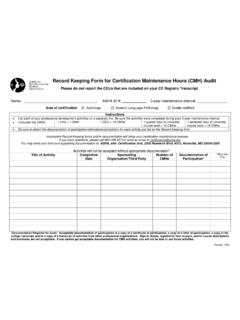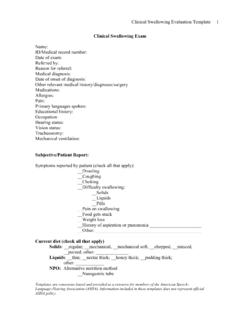Transcription of FAQs on Swallowing Screening: Special Emphasis on …
1 Frequently Asked Questions (FAQ) on Swallowing screening : Special Emphasis on Patients With Acute Stroke This FAQ was originally developed in 2006 by members of the Steering Committee of Special Interest Division 13 ( Swallowing and Swallowing Disorders) of the American Speech-Language- Hearing Association: Nancy Swigert (chair), Luis Riquelme, and Catriona Steele. The present version was updated in September 2009. The FAQ expresses the opinions and views of the individual authors and does not represent any official position or policy of the American Speech- Language-Hearing Association or any Special Interest Division. Reference herein to any specific program, product, process, service, or manufacturer does not constitute or imply endorsement or recommendation by ASHA or any Division. Why this is an issue: Many acute care facilities and stroke centers have standards in which it is expected that screening for dysphagia will be performed and documented on all ischemic/hemorrhagic stroke patients (including those with transient ischemic attacks) before food, fluids, or medication are given by mouth ( Joint Commission on the Accreditation of Health Care Organizations, 2004).
2 screening methods may include, but are not limited to, (a) water swallow tests, such as the Burke water swallow test (De Pippo, Holas, Reding, Mandel, & Lesser, 1994) or the 3 oz. water swallow test (Suiter & Leder, 2008); (b) Swallowing screening protocols including brief assessments of oral motor and sensory function as well as water swallow tests, such as the Toronto Bedside Swallowing screening Test (TOR-BSST; Martino et al., 2009) or the Simple Standardized Bedside Swallowing Assessment (SSA; Perry, 2001); or (c) clinical (bedside). swallow examinations. Given the range of procedures that can be used for Swallowing screening , this FAQ document outlines answers to frequently asked questions by speech-language pathologists (SLPs) regarding Swallowing screening . DEFINITION Basic Description of the Issue 1. What is the definition of Swallowing screening ? The term Swallowing screening is generally used to refer to a minimally invasive evaluation procedure that provides quick determination of - the likelihood that dysphagia exists.
3 - whether the patient requires referral for further Swallowing assessment;. - whether it is safe to feed the patient orally (for the purposes of nutrition, hydration, and administration of medication);. - whether the patient requires referral for nutritional or hydrational support. However, the majority of screening procedures described in the literature are rather narrow and have focused only on identifying overt signs of aspiration, rather than being broader screening procedures that address the range of aspects listed above. 2. What questions can a screening procedure answer with respect to Swallowing ? screening procedures are usually used to determine whether any of the following represent a risk of dysphagia and/or a reason to maintain an NPO (nil per oris, or nothing-by-mouth) status for the patient: - a known history of dysphagia;. - a medical diagnosis that frequently involves Swallowing impairment ( , stroke);. - reduced level of consciousness.
4 - overt signs of aspiration;. - overt signs or complaints of difficulty Swallowing . 3. What kinds of screening procedures have been used for dysphagia in the past? The literature contains many examples of different Swallowing screening procedures: - questionnaires or interviews with the patient and/or caregiver to ask whether they are aware of any past or current Swallowing difficulties (Mari et al., 1997);. - medical history review for etiological risk categories (Mari et al., 1997);. - evaluation of gag reflex or pharyngeal sensation (Kidd, Lawson, Nesbitt, & MacMahon, 1993);. - observation for overt signs of cough or other difficulty during planned trial swallows ( , water) or routine oral intake (Kidd et al., 1993);. - observation of the patient for combinations of specific clinical signs from oral motor and speech motor examinations as well as trial swallows with water (Daniels, Ballo, Mahoney, &. Foundas, 2000; Logemann, Veis, & Colangelo, 1999).
5 - use of decision-making algorithms considering several factors (Runions, Rodrigue, & White, 2004);. - observation for occurrence of cough during or following water swallows (De Pippo, Holas, &. Reding, 1994; Kidd et al., 1993);. - observation for changes in voice quality postswallow as a potential marker for aspiration (Ryu, Park, & Choi, 2004; Warms & Richards, 2000);. - pulse oximetry as a means of detecting decreases in arterial blood oxygenation as a possible marker for aspiration (Collins & Bakheit, 1997; Colodny, 2000; Edwards, 2002; Exley, 2000;. Leder, 2000; Lim et al., 2001; Sellars, Dunnet, & Carter, 1998; Sherman, Nisenboum, Jesberger, Morrow, & Jesberger, 1999; Smith, Lee, O'Neill, & Connolly, 2000; Zaidi et al., 1995);. - cervical auscultation (Leslie, Drinnan, Finn, Ford, & Wilson, 2004; Zenner, Losinski, & Mills, 1995);. - the laryngeal cough reflex, which looks for a cough response to inhalation of tartaric acid as a marker of the integrity of laryngeal sensation (Addington, Stephens, & Gilliland, 1999).
6 INDICATORS/EVIDENCE FOR screening . 4. What is the reported incidence of dysphagia in acute stroke? Dysphagia has been reported to occur in 42% 60% of acute stroke patients on the basis of standardized clinical bedside Swallowing assessments performed within a median of 3 days from stroke diagnosis (Mann & Hankey, 2001). Videofluoroscopic Swallowing assessments performed within a median of 10 days from stroke diagnosis have been reported to detect Swallowing abnormalities in 55% 72% of acute stroke patients (Mann & Hankey, 2001). These estimates are considered conservative. In particular, the estimates based on videofluoroscopy are likely to underestimate the initial incidence of dysphagia poststroke, given that dysphagia is thought to resolve in the immediate poststroke interval in some cases (Mann & Hankey, 2001). 5. What is the reported incidence of aspiration in acute stroke? - The reported incidence of dysphagia in stroke varies from 37% to 78% depending on the type of test used to determine the presence of dysphagia.
7 Cursory screening techniques have the lowest detection rates for dysphagia following stroke (37% 45%; Martino, Foley, Bhogal, Diamant, Speechley, & Teasell, 2005). - Aspiration has been reported to occur in 38% 70% of acute stroke patients (Daniels et al., 1998; Horner & Massey, 1988; Horner, Massey, Riski, Lathrop, & Chase, 1988; Linden &. Siebens, 1983). - Silent aspiration occurs in 40% 67% of patients with dysphagia who aspirate (Daniels et al., 1998; Splaingard, Hutchins, Sulton, & Chaudhuri, 1988). - Silent laryngeal penetration and aspiration of liquids are reported to be more common in right hemisphere than in left hemisphere cortical strokes (Robbins, Levine, Maser, Rosenbek, &. Kempster, 1993). - There is an increased relative risk of pneumonia in stroke patients with dysphagia ( vs. individuals without dysphagia). This relative risk is even greater ( ) in stroke patients with documented aspiration (Martino et al., 2005). 6. How have screening procedures been evaluated in the literature?
8 Swallowing screening procedures have been studied for their accuracy in identifying aspiration or dysphagia. The overwhelming majority of studies in this regard have compared the outcomes of a screening evaluation to the results of a videofluoroscopic Swallowing examination conducted at a later time. You may encounter the following terms when reading about Swallowing screening procedures in the literature: Construct validity: the extent to which a test (in this case, a Swallowing screening procedure). measures the intended theoretical construct or trait (in this case, the presence or absence of risks for dysphagia and/or aspiration). Sensitivity: the number of patients with a Swallowing problem who are correctly identified by the screening procedure as having a Swallowing problem. Specificity: the number of patients with no Swallowing problem who are correctly identified by the screening procedure as not having a Swallowing problem. Positive predictive value: the sensitivity of the screening procedure for detecting Swallowing difficulty multiplied by the true prevalence of dysphagia in the population.
9 Negative prediction value: the specificity of a screening procedure for accurately detecting an absence of Swallowing difficulty multiplied by the true prevalence of a lack of dysphagia in the population. False positive (also known as Type II error): determination using a screening procedure that a patient has a Swallowing problem when in fact that patient has no Swallowing problem. A. procedure with high sensitivity would have a low rate of false positives. False negative (also known as Type I error): determination using a screening procedure that a patient has no Swallowing problem when in fact that patient does have a Swallowing problem. A procedure with high specificity would have a low rate of false negatives. Likelihood ratios: A combination of the sensitivity and specificity of a Swallowing screening test that tells you how much a positive or negative result changes the likelihood that a patient would have dysphagia. The likelihood ratio of a positive test result (LR+) is defined as sensitivity divided by 1 minus specificity.
10 LR+ = sensitivity 1 specificity The likelihood ratio of a negative test result (LR ) is defined as 1 minus sensitivity divided by specificity. LR = 1 sensitivity specificity 7. What is the evidence for the different screening procedures in terms of sensitivity and specificity? There is general consensus that Swallowing screening procedures have broad construct validity;. that is, they measure the presence of clinical signs and symptoms that are considered relevant as indicators of the presence or absence of dysphagia. Two systematic reviews have been reported in the literature regarding the evidence supporting Swallowing screening procedures (Martino, Pron, & Diamant, 2000; Perry & Love, 2001). Neither review concluded that any single approach to screening has both good sensitivity and specificity in identifying the likelihood that dysphagia or aspiration exists. PROCEDURE ADMINISTRATION: 8. What are the different models of Swallowing screening that might be considered for use?
